EMEA Marketer’s Content Toolbox: How to Drive Growth Through Content (Part 1)
Content is the number one building block in the overarching category of customer experience (CX). How to successfully build your content efforts, in the ever-shifting move to more and more digital engagement, is a hard yet important strategy to understand as you are laying the foundation for your customer experience model. This blog, from TechTarget Customer Success and MOI Global, outlines the steps you can take to build your best customer experience content framework.
Content and the customer experience
Customer experience can be summed up as: “The sum-total of all feelings and interactions a customer has with your brand, at every point of their buying journey – from marketing to sales to customer service and everywhere in between.”
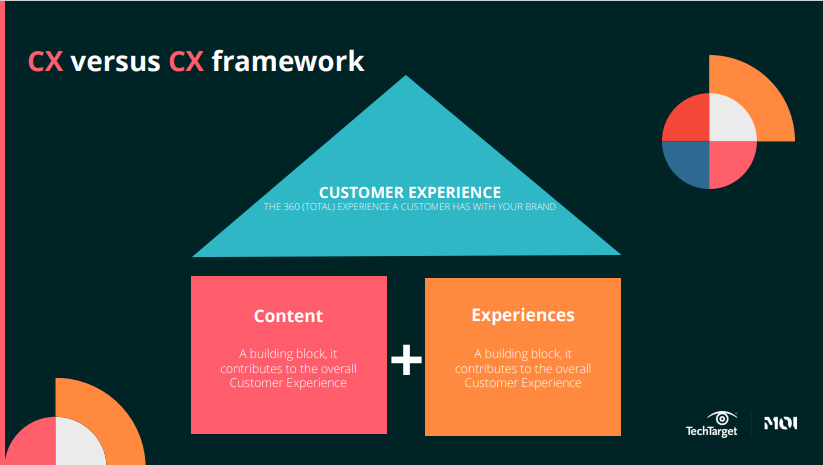
If CX is the totality of interactions, a huge portion of those interactions will be with content.
Customer experience forces us to balance our customer and prospects’ needs with our commercial goals. There is no finish line in CX – it’s a journey without a destination. This is important if we are to truly meet the needs of prospects and customers while also generating leads for the business.
Customer Experience is: The sum-total of all feelings and interactions a customer has with your brand, at every point of their buying journey – from marketing to sales to customer service and everywhere in between.
– TechTarget | MOI Global
The two building blocks that go into creating the customer experience are ‘content’ and ‘experiences’. Let’s break those down:
Understand the Content building block
‘Content’ is a standalone asset that can live in a variety of channels. Inherent mobility means that the asset can be shared, can move around the web, or travel with the customer. Content could be blog posts, a research study, white paper, video, etc. – powerful tools for engaging prospects and customers.
The interaction with content is fairly passive – reading, watching, or listening. And that is measured with initiations like downloading a paper after filling out a form (opens, downloads, or plays), whether someone spent time with the piece of content (watch/listen duration), and completions – whether someone got to the end of the piece of content.
Understand the Experience building block
In contrast, an experience is a series of interactions within a defined environment. It has a point of entry and a point of exit – it’s something to be navigated. An experience may include various forms of content but it is something you immerse yourself in and work your way through.
Examples of an experience would be a landing page that you explore by clicking into different modules, an HTML email that you scroll through and then tap the call-to-action button at the end, a mobile app, an eBook, or an online survey.
A customer or prospect would interact within a user interface (UI) using digital gestures like clicking, tapping, typing, scrolling, etc. And success would look like time spent on the site, web sessions, bounce rates, pages visited, forms filled out, leads generated, and return visits over time.
Content x Experience cross-over
To clarify, an asset can act as both content and experience.
In the image below, you can see that the same piece of content can be used as either a static PDF or can be transformed into an interactive experience where users navigate through the content and take actions to choose their journey through the asset. This could include clicking on the next chapter, drilling down to sub-pages, and more.
The PDF content is reconsidered to provide different journey options for the user. It’s the same thought leadership expressed in different ways and used in the customer journey in different ways.
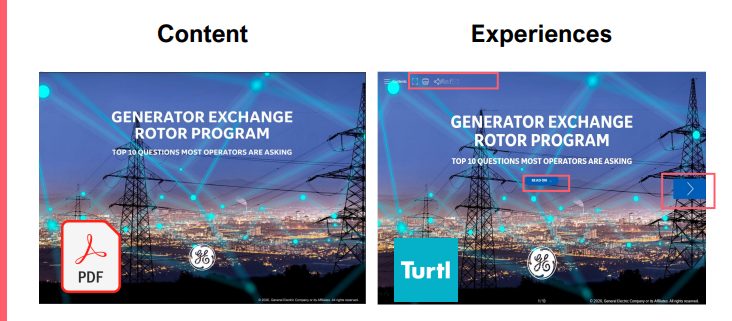
Before you create another piece of content, stop to consider whether the information or entertainment would be best expressed as a static piece of content or as an experience, or perhaps repurposed for both. You have a huge range of options, so choose how to best engage people and deliver an outstanding customer experience.
The power of content
Content is all about customer-centricity – whether that be reaching potential customers or current customers.
To potential customers, content demonstrates that you understand your prospect’s business context and can help them solve their problems. It shows empathy. It also gives prospects confidence in what you do.
For current customers, content helps them advance their understanding of your value, delivered via various products, services, capabilities, support, and expertise.
The power of content marketing
Content marketing, in contrast, is all about the brand and the business. It’s an engine to drive growth.
Content marketing is the practice of delivering content that’s valuable, consistent, and relevant to a clearly defined audience over time. And ultimately, the aim is to drive profitable customer action.
Content marketing serves the brand and drives revenue through:
- Credibility: Establish thought leadership
- Discoverability: Build SEO through expertise, authority, and trustworthiness
- Profitability: Generate qualified leads or increase revenue with existing customers
Types of B2B content and experiences
Here is a simple illustration of many types of B2B content that you could create today or aspire to create.
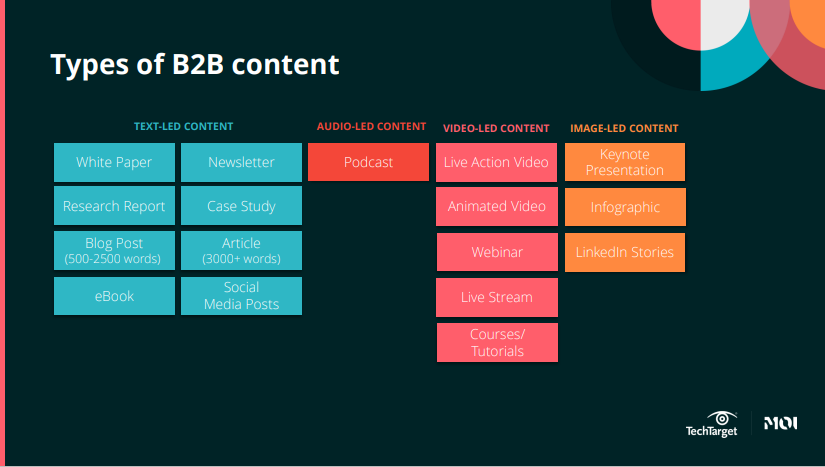
Podcasts break out of the traditional text-based content we see in B2B, and assets like courses and assessments are more innovative in the B2B technology space. Visual and video-led content is still underutilized in B2B so you could stand out with more of those.
As for B2B experiences, there are several listed below that you may have seen, and some that are more innovative in this sector. This is just an inspiration list of digital interactions and experiences that you may want to explore in your own organization.
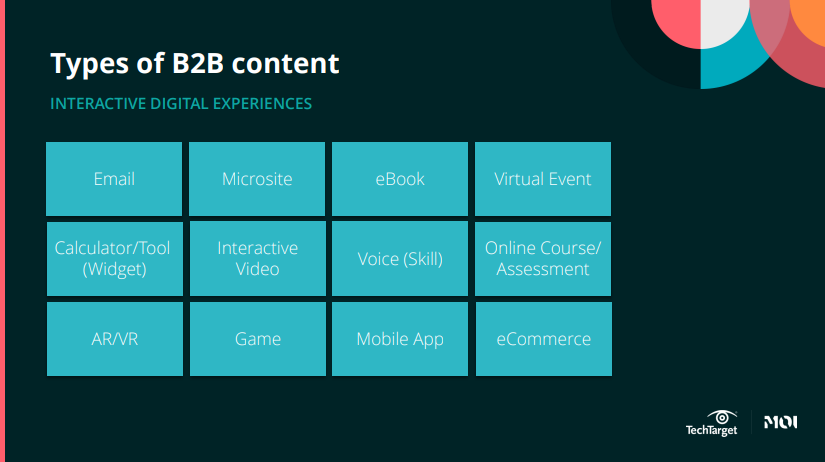
But how do you put all this information together into a content marketing plan? You need to create a joined-up customer experience through your content marketing.
A content marketing blueprint
Glenn Landauer, VP Customer Experience Strategy from MOI Global, shared his simple strategic blueprint for content marketing that is broken down into three steps.
- Establish your content strategy
- Think about how you are going to produce your content – the level of fidelity, iterative or intensive, and will it be custom or a pool of assets
- Distribution – make sure it gets in front of the right audience
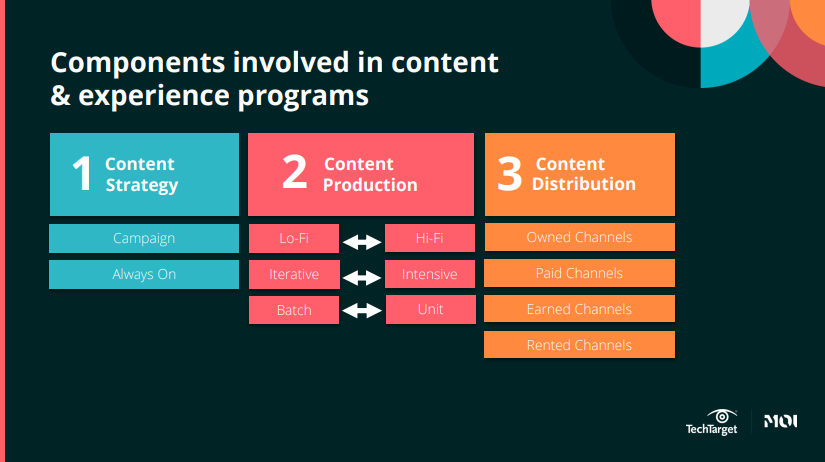
How to optimize your content marketing
As a content marketer, think over these questions to create an exceptional customer experience that joins together all we’ve covered so far:
- How can content and experiences help guide your prospects through the buyer journey? Are there gaps your content and experiences can fill or new discovery paths they can reveal?
- Where will content support awareness (brand) vs. consideration (platforms and solutions) vs. conversion goals (specific products and offerings)?
- You don’t need to do everything – focus on a few things you can execute well. What are they?
Don’t be afraid to experiment but stick with an idea for a while to see how it truly performs.
In the next blog post, we’ll look at how B2B tech buyer research behaviors have changed over the past two years and what that means for how you go to market with your content and experiences.
This blog provides unique perspectives and expertise based on our direct experiences within the EMEA market and is designed to be a resource for marketers targeting or working directly within this market.
content marketing, customer experience, CX, EMEA Content Marketing, EMEA marketing strategies



